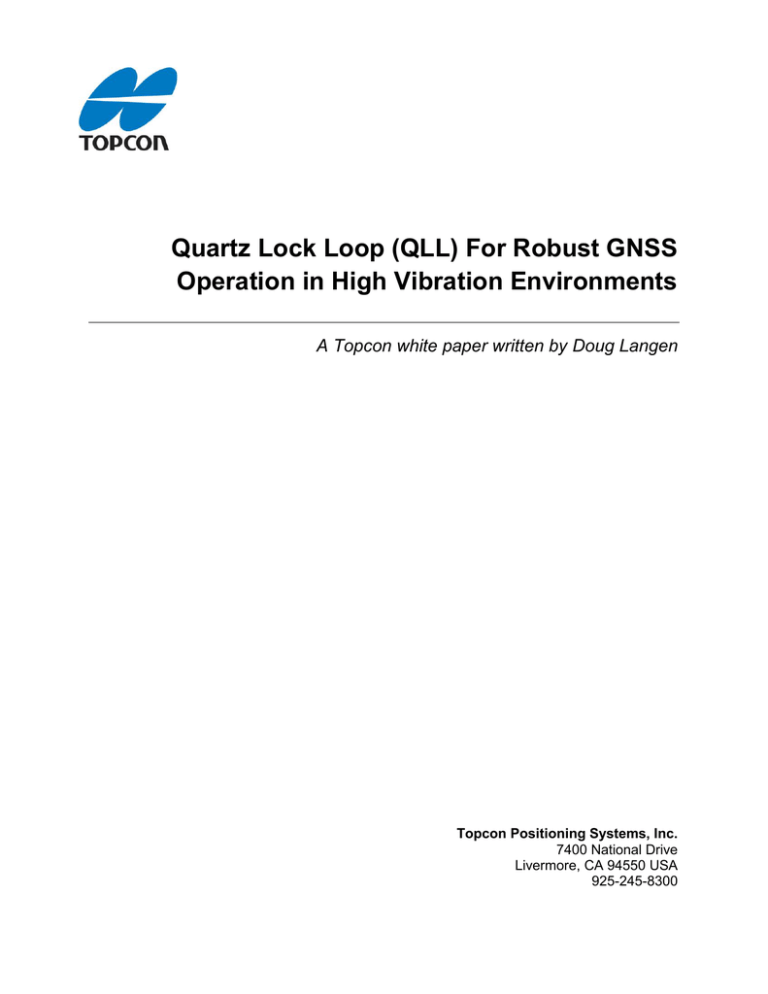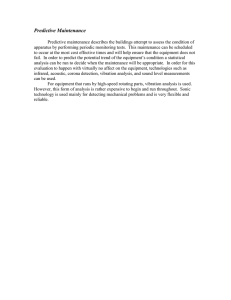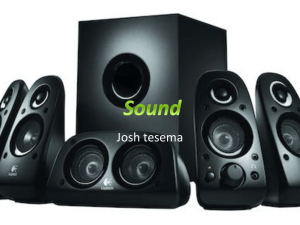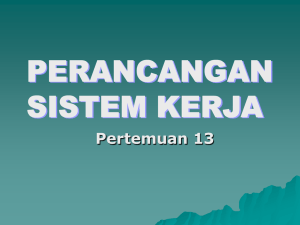
Quartz Lock Loop (QLL) For Robust GNSS
Operation in High Vibration Environments
A Topcon white paper written by Doug Langen
Topcon Positioning Systems, Inc.
7400 National Drive
Livermore, CA 94550 USA
925-245-8300
www.topconpositioning.com
About the author
Doug Langen is a professional engineer with a degree in geomatics engineering from
the University of Calgary. He has worked in the GNSS industry for more than a decade
contributing to research and development, application engineering, sales support and
product management. He joined Topcon in 2011 as a product manager of GNSS.
© 2012. Topcon Positioning Systems, Inc. All Rights Reserved.
This document and translations of it may be copied and furnished to others, and separate works
that comment on or otherwise explain it or assist in its implementation may be prepared, copied,
published, and distributed, in whole or in part, without restriction of any kind, provided that the
above copyright notice and this section are included on all such copies and separate works.
Notwithstanding the above, this document itself may not be modified in any way, including by
removing the copyright notice or references to Topcon or Topcon Positioning Systems, without
the written permission of Topcon. This document and the information contained herein is
provided on as “AS IS” basis and Topcon Positioning Systems disclaims all warranties, express
or implied, including but not limited to any warranty of non-infringement, merchantability or
fitness for a particular purpose.
Quartz Lock Loop
2
Quartz Lock Loop (QLL) For Robust GNSS Operation in
High Vibration Environments
Abstract
All dynamic GNSS applications are subject to some degree of bumps, vibration and mechanical shock
that can cause inaccurate measurements or complete satellite tracking failure due to impact on a
receiver’s quartz crystal oscillator. In September 2012 Topcon Positioning Systems (TPS) announced the
release of firmware v4.0 introducing Quartz Lock Loop™ (QLL) technology on all Topcon OEM GNSS
platforms. Designed by Topcon engineers for superior GNSS tracking in high-vibration environments,
QLL technology is an exclusive approach to mitigating the effects of shock and vibration through
patented firmware algorithms.
This paper discusses the effects of vibration, acceleration and shock on GNSS integrity, how QLL
mitigates the effects for robust operation in any dynamic condition and compares performance of two
industry competitors during a comprehensive vibration and shock test.
Introduction
Most high precision GNSS receivers use crystal oscillators to establish a precise timing signal, which
relies on the natural resonant vibration of a quartz crystal. This conventional approach can provide
suitable performance in smooth dynamics, but when exposed to severe real-word vibration and shock
these simple systems can destabilize quickly, leading to inaccurate GNSS measurements or even
complete satellite tracking failure.
By using advanced feedback loops, Topcon’s patented QLL continuously monitors system behavior to
detect and remove any fluctuations that may cause tracking problems – over a full range of vibration
frequencies and magnitudes. This allows for a clean, stable timing reference signal to be preserved
through strong acceleration, vibration and bumps --- for uninterrupted and reliable precise positioning.
Comprehensive testing was performed at an independent laboratory testing the performance of QLL
technology alongside two competing GNSS receiver boards from two separate brands. All boards were
tested at a wide variety of vibration frequencies with varying magnitudes in all orientations to simulate
the conditions of real world dynamic GNSS applications. The results of the test show how GNSS
performance can be quickly compromised without the use of sophisticated GNSS technology.
Quartz Lock Loop
3
Crystal Oscillators in GNSS
GNSS receivers calculate position by a process called trilateration, which uses precisely determined
distances to a minimum of four satellites with known locations and intersects them to determine the
receiver’s location. Since GNSS satellites signals travel at the speed of light, the distance or range to
each satellite is determined by precisely measuring the time it takes signals transmitted by high-orbit
GNSS to reach the receiver and multiplying this transit time by the speed of light. At the speed of light, a
1 microsecond error in time measurement corresponds to a 300m ranging error to each satellite,
highlighting the importance of accurate time measurement. GNSS satellites use atomic clocks to
achieve timing accuracies at the nanosecond scale, however, users on the ground cannot afford atomic
clocks at both the expense and power levels. Consequently, most GNSS receivers use quartz crystal
clocks, which rely on the natural resonant frequency of crystal to offer reliable timing stability in ideal
conditions. Since quartz clocks are not as accurate as atomic clocks they must be calibrated in real time
by the GNSS receiver to achieve suitable time measurement accuracy for satellite ranging and
positioning. When, however, the oscillators are subjected to rapid temperature fluctuations or intense
vibration or acceleration this induces spurious responses in frequency causing unpredictable timing
errors. This frequency drift and unpredictable fluctuation is a common source of signal tracking
degradation or failure in GNSS applications.
Quartz Lock Loop (QLL) Technology Design
Quartz crystal oscillators mounted on GNSS boards are regularly subjected to a wide variety of
accelerations, vibrations and shock. Depending on the magnitudes and frequencies experienced, forces
can cause the oscillations of a quartz crystal to either drift or “burst” making it difficult to maintain an
accurate timing signal for GNSS measurements. Users will experience either a positioning degradation
or complete failure in satellite tracking altogether.
Topcon engages in many vibration-prone applications, such as machine control, agriculture and marine,
and as a result, Topcon engineers were tasked with creating a technology that would withstand the
effects of quartz crystal oscillator instability in high-vibration conditions. The response: QLL technology
– a software algorithm that mitigates quartz crystal limitations over a full range of vibration frequencies
and magnitudes. This algorithm allows for a clean, stable timing reference signal to be preserved
through strong acceleration, vibration and bumps for uninterrupted and reliable precise positioning.
QLL technology is based on dynamic feedback loops that monitor the health of the quartz crystal
oscillator throughout the GNSS operation. Using broadband loops the frequency drifts and bursts are
detected and removed from the timing signal to produce a clean timing reference for uninterrupted
satellite tracking even in the worst vibration conditions.
Quartz Lock Loop
4
Dynamics and Vibrations Testing
GNSS receivers are used on many vehicles and vessels – passenger cars, construction machinery, marine
vessels, military vehicles, airborne platforms – all with their own dynamic behavior. Accelerations
caused by motion, such as gravity and engine propulsion, in combination with environmental factors,
such as bumpy roads, waves and turbulence, are just a fraction of the influences to a vehicles dynamics.
When the design variables of a vehicle, such as center of mass, weight distribution and body flex, are
added to the equation dynamics of a vehicle becomes very complex with mechanical vibration being one
of the more difficult behaviours to predict and model. Consequently, systems should be designed to
withstand the widest range of vibration conditions possible to minimize the chance the operational
disruption.
MIL-STD-810, among other test standards, was developed by the U.S. military to validate that a device is
able to operate and endure the conditions that it will experience throughout its service life. Although
prepared specifically for military applications, the standard is also used to test the environmental
integrity of commercial products. As part of this initiative, chamber test methods were developed that
replicate the effects of environments on the equipment rather than imitating the environments
themselves. For vibration testing a device is mounted to an electrohydraulic or electrodynamic shake
table and operational health is monitored as the unit is submitted to a wide spectrum of accelerations
and vibrational magnitudes and frequencies. To classify the vibration performance of a device two types
of vibration tests are performed – sinusoidal vibration testing and random vibration test.
Sinusoidal Vibration Testing
Sinusoidal vibration testing attempts to model oscillations constant in frequency, typically in the lower
frequency spectrum (less than 100 Hz). This simulates vibration caused by the vehicle itself, such as
engine vibration, drive train vibration aerodynamic vibration, by auxiliary equipment mounted on the
vehicle (pumps, fans, drills, artillery) and by the operational environment, such driving over bumps at
high speeds and scraping construction surfaces. All devices under vibration have resonant frequencies
where the system tends to oscillate with greater amplitude at some frequencies than at others, and
therefore, may be the most operationally harmful. Consequently, sinusoidal vibration testing involves a
wide range of frequencies in a test called a sine sweep, where vibration is started at a low frequency (3
Hz) and gradually increased to an upper limit (100 Hz). As the frequency is increased multiple resonant
frequencies are tested to validate that the device is able to provide operational stability throughout the
sine sweep.
Quartz Lock Loop
5
Random Vibration Testing
Random vibration testing models oscillations found in everyday life scenarios that are non-deterministic
in nature unlike sinusoidal waveforms. This simulates “real-world” random vibrations, such as bumps
experienced due to rough roads, waves and turbulence. Random vibration testing is conducted by
instantaneously subjecting a device to a wide range of vibrational frequencies at short, random
intervals, rather than gradually increasing vibration frequency used in sinusoidal testing.
Test Details
On October 30, 2012, sinusoidal and random vibration testing was conducted at an independent test lab
to determine the performance benefits of QLL technology and to benchmark it against two GNSS
industry competitors. GNSS receivers were tested at the board level to remove any hardware related
biases by hard mounting each GNSS board directly to the shake table with communications lines and
satellite signal cables connected directly to each board (figure 1). To test the orientation susceptibility,
each board was tested in all three axes for all random and sinusoidal test configurations. Testing each
orientation of a GNSS receiver indicates the suitability and mounting flexibility in a high dynamic
application. Both electrohydraulic and electrodynamic shaker systems were used to test both low and
high-frequency vibration.
Figure 1: Electrohydraulic and electrodynamic test setups in all three orientations (X, Y and Z
respectively).
Nineteen tests were conducted in total to test a variety of vibrational accelerations and frequencies to
determine each GNSS boards vibration resistance to vibration to the point of failure. Accelerations
ranged from 2g to 23g with frequency ranges of 3 Hz to 2000 Hz.
Raw data was logged from all GNSS receivers throughout the test to monitor signal quality, quantity of
satellites tracked and positioning accuracy. The passing criteria for each test were not only whether or
not position accuracy has been compromised, but also whether or not satellite signal tracking failure
occurred.
Quartz Lock Loop
6
Results
Table 1, below, summarizes the details and results of each test conducted:
Table 1: Sinusoidal vibration test details and results.
Test
Axis
Acceleration,
g
Frequency,
Hz (lower)
Frequency,
Hz (upper)
Topcon
Receiver A
Receiver B
1.1
X
2
5
30
Pass
Pass
Pass
1.2
X
4
3
30
Pass
Pass
Fail
1.3
X
6
3
30
Pass
Pass
Fail
1.4
X
6
3
100
Pass
Pass
Fail
1.5
X
8
3
50
Pass
Pass
Fail
1.6
X
10
3
30
Pass
Pass
Fail
1.7
Y
8
3
50
Pass
Fail
Pass
1.8
Y
10
3
30
Pass
Fail
Pass
1.9
Z
8
3
50
Pass
Pass
Pass
1.10
Z
10
3
30
Pass
Pass
Fail
Table 2: Random vibration test details and results.
Test
Axis
Acceleration,
g RMS
Frequency,
Hz (lower)
Frequency,
Hz (upper)
Topcon
Receiver A
Receiver B
2.11
X
7.7
20
2000
Pass
Pass
Pass
2.12
X
19.4
20
2000
Pass
Pass
Fail
2.13
X
23
20
2000
Pass
Pass
Fail
2.14
Y
7.7
20
2000
Pass
Pass
Fail
2.15
Y
19.4
20
2000
Pass
Pass
Fail
2.16
Y
23
20
2000
Pass
Pass
Fail
2.17
Z
7.7
20
2000
Pass
Pass
Pass
2.18
Z
19.4
20
2000
Pass
Pass
Fail
2.19
Z
23
20
2000
Pass
Fail
Fail
It should be noted that the Topcon receiver with QLL passed all tests through both the sinusoidal and
random tests. These results are expanded upon in the position and tracking domains illustrated in the
figures below.
Quartz Lock Loop
7
Sinusoidal Vibration Testing at Specification (4g)
End
23 Hz
6 Hz
16 Hz
Height (m)
A common sinusoidal vibration specification for GNSS receivers is a resistance to 4g of acceleration
without any operational disturbances. The results of test 1.2 are shown below, which is a 4g sinusoidal
vibration test in the X axis.
UTC Time (HH:MM:SS)
End
23 Hz
6 Hz
16 Hz
# Satellites
Figure 2: Height position stability during sinusoidal vibration test at 4g (3-30 Hz) on the X-axis.
UTC Time (HH:MM:SS)
Figure 3: Satellite tracking stability during sinusoidal vibration test at 4g (3-30 Hz) on the X-axis.
As figures 2 and 3 show, Topcon and Receiver A were unaffected by the 4g sinusoidal vibration, while
Receiver B had significant position stability problems starting at 6 Hz due to frequent tracking failures to
multiple satellites during the test.
Quartz Lock Loop
8
Sinusoidal Vibration Testing at Test Lab Limits (10g)
End
6 Hz
Height (m)
Testing was repeated on the X-axis until the breaking point of each receiver was successfully
determined, or when the limits of the test lab shake table were reached. Acceleration magnitudes were
incrementally increased until either scenario occurred – QLL technology exceeded the limit of the test
lab.
UTC Time (HH:MM:SS)
End
6 Hz
# Satellites
Figure 4: Height position stability during sinusoidal vibration test at 10g (3-30 Hz) on the X-axis.
UTC Time (HH:MM:SS)
Figure 5: Satellite tracking stability during sinusoidal vibration test at 10g (3-30 Hz) on the X-axis.
Again, figures 4 and 5 illustrate that Topcon and Receiver A were unaffected by the 10g sinusoidal
vibration, while Receiver B had a complete tracking and positioning failure starting at 6 Hz. Both
sinusoidal vibration tests at 6g (tests 1.3 and 1.4) and testing at 8g (test 1.5) also showed that
Competitor B experienced complete tracking and positioning failure at around 6 Hz and persisting until
30Hz of vibration.
Quartz Lock Loop
9
END
UTC Time (HH:MM:SS)
13 Hz
3 Hz
Height (m)
When sinusoidal vibration testing changed orientation from the X-axis to the Y-axis, Receiver A
experienced disturbances:
END
3 Hz
13 Hz
# Satellites
Figure 6: Height position stability during sinusoidal vibration test at 10g (3-30 Hz) on the Y-axis.
UTC Time (HH:MM:SS)
Figure 7: Satellite tracking stability during sinusoidal vibration test at 10g (3-30 Hz) on the Y-axis.
In this test, Topcon and Receiver B were unaffected by the 10g sinusoidal vibration at all frequencies,
while Receiver A had significant position and tracking stability problems starting at 3 Hz. At 13 Hz
competitor A completely lost satellite tracking and didn’t restore it till the end of the test. Testing
performed in the Y-axis at 8g showed that competitor A had similar disruptions starting at 3 Hz and
enduring until vibration frequency reached 20 Hz.
Quartz Lock Loop 10
Random Vibration Testing at Specification (7.7g RMS)
Height (m)
A common random vibration specification for GNSS receivers is a resistance to 7.7g RMS of acceleration
without any operational disturbances. The results of test 2.14 are shown below, which is a 7.7g RMS
random vibration test in the Y-axis.
UTC Time (HH:MM:SS)
Figure 8: Height position stability during random vibration test at 7.7g RMS (20-2000 Hz) on the Y-axis.
Even though no satellite signals appeared to be dropped throughout the test, random vibration proved
to have a negative effect on the positioning stability of Receiver B.
Random Vibration Testing at 19.4g RMS
Height (m)
When random vibration intensity was increased to 19.4g RMS Receiver B experienced instability in
positioning in all axis orientations, while Topcon and Receiver A operate without flaws:
UTC Time (HH:MM:SS)
Figure 9: Height position stability during random vibration test at 19.4g RMS (20-2000 Hz) on the X-axis.
Quartz Lock Loop 11
Random Vibration Testing at Test Lab Limits (23g RMS)
Height (m)
Similar to sinusoidal vibration testing, random had to be performed until the limits of the test lab were
reached since QLL technology did not reach its breaking point. At 23g RMS Receiver B showed severe
problems in positioning and tracking stability on all three axes (example for X-axis see below):
# Satellites
Figure 10: Height position stability during random vibration test at 23g (20-2000 Hz) on the X-axis.
UTC Time (HH:MM:SS)
Figure 11: Satellite tracking stability during random vibration test at 23g (20-2000 Hz) on the X-axis.
Quartz Lock Loop 12
Height (m)
The Topcon receiver with QLL enabled operated without any problems at 23g RMS on all three axes.
Competitor A experiences stability problems at 23gRMS when vibration axis was Z:
UTC Time (HH:MM:SS)
# Satellites
Figure 12: Height position stability during random vibration test at 23g (20-2000 Hz) on the Z-axis.
UTC Time (HH:MM:SS)
Figure 13: Satellite tracking stability during random vibration test at 23g (20-2000 Hz) on the Z-axis.
Quartz Lock Loop 13
Conclusion
GNSS application areas are growing and GNSS technology will consistently be subjected to vibration and
shock as adoption continue to grow and expand into other areas and niche markets. The susceptibility
of crystal oscillators to vibration and shock can be a limiting factor in operation of GNSS receivers in
demanding dynamic environments if the GNSS manufacturer does not have the suitable technology to
overcome dynamic barriers. Through comprehensive sinusoidal and random vibration testing, QLL
technology has proven to allow Topcon receivers to provide stable satellite tracking and positioning in a
wide spectrum of vibration frequencies, at intense magnitudes and in any orientation. However, testing
two different GNSS receiver products shows vulnerabilities at many vibration frequencies and
magnitudes with orientation dependent sensitivity. For dynamic GNSS applications with operational
expectations that cannot be compromised during any degree of vibration, QLL technology ensures the
best in satellite navigation accuracy and availability in the industry.
This statement holds great value to customers using Topcon turnkey systems or integrating Topcon OEM
GNSS receivers: QLL Technology assures the most robust GNSS positioning performance on the market
in dynamic real world applications.
Quartz Lock Loop 14





